4 资源基础观的理论发展
- 格式:pdf
- 大小:1.06 MB
- 文档页数:70
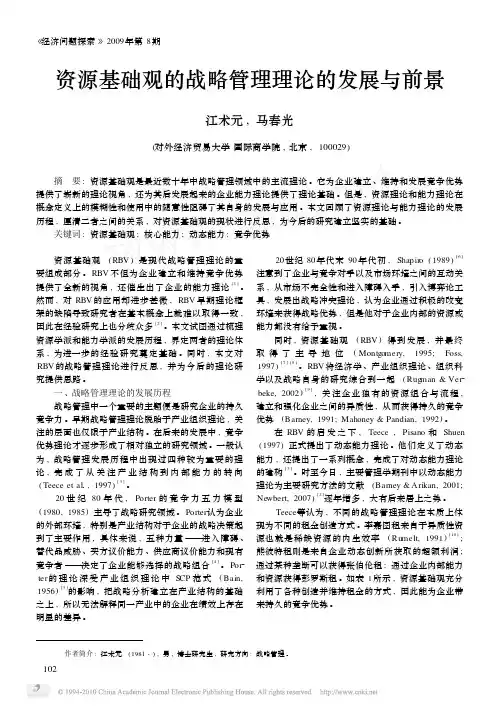
作者简介:江术元(1981-),男,博士研究生,研究方向:战略管理。
《经济问题探索》2009年第8期资源基础观的战略管理理论的发展与前景江术元,马春光(对外经济贸易大学国际商学院,北京,100029)摘 要:资源基础观是最近数十年中战略管理领域中的主流理论。
它为企业建立、维持和发展竞争优势提供了崭新的理论视角,还为其后发展起来的企业能力理论提供了理论基础。
但是,资源理论和能力理论在概念定义上的模糊性和使用中的随意性阻碍了其自身的发展与应用。
本文回顾了资源理论与能力理论的发展历程,厘清二者之间的关系,对资源基础观的现状进行反思,为今后的研究建立坚实的基础。
关键词:资源基础观;核心能力;动态能力;竞争优势 资源基础观(RBV )是现代战略管理理论的重要组成部分。
RBV 不但为企业建立和维持竞争优势提供了全新的视角,还催生出了企业的能力理论[1]。
然而,对RBV 的应用却进步甚微,RBV 早期理论框架的缺陷导致研究者在基本概念上就难以取得一致,因此在经验研究上也分歧众多[2]。
本文试图通过梳理资源学派和能力学派的发展历程,界定两者的理论体系,为进一步的经验研究奠定基础。
同时,本文对RBV 的战略管理理论进行反思,并为今后的理论研究提供思路。
一、战略管理理论的发展历程战略管理中一个重要的主题便是研究企业的持久竞争力。
早期战略管理理论脱胎于产业组织理论,关注的层面也仅限于产业结构。
在后来的发展中,竞争优势理论才逐步形成了相对独立的研究领域。
一般认为,战略管理发展历程中出现过四种较为重要的理论,完成了从关注产业结构到内部能力的转向(Teece et al 1,1997)[3]。
20世纪80年代,Porter 的竞争力五力模型(1980,1985)主导了战略研究领域。
Porter 认为企业的外部环境,特别是产业结构对于企业的战略决策起到了主要作用,具体来说,五种力量———进入障碍、替代品威胁、买方议价能力、供应商议价能力和现有竞争者———决定了企业能够选择的战略组合[4]。
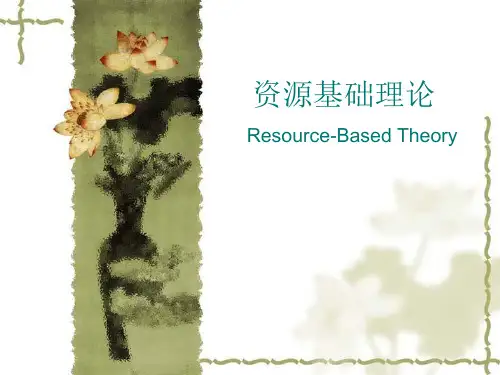
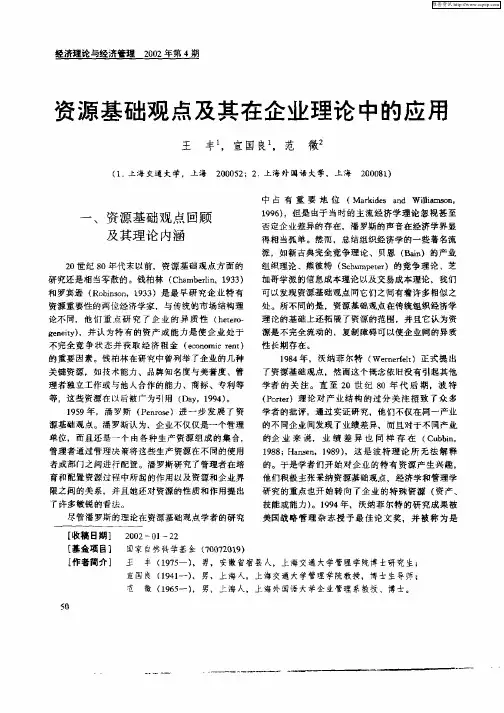
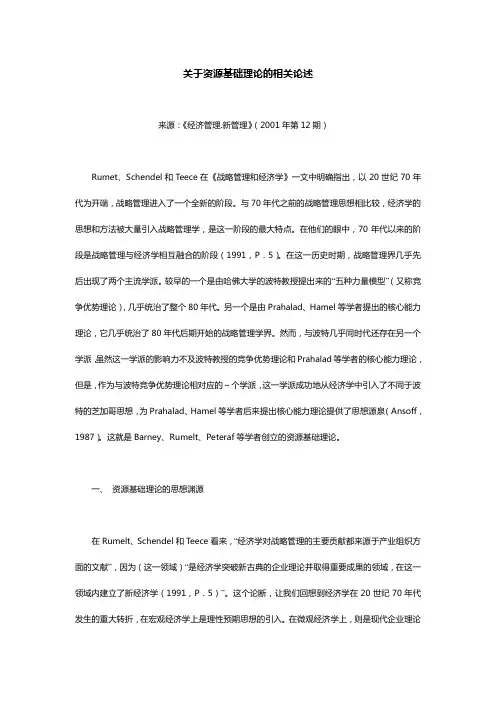
关于资源基础理论的相关论述来源:《经济管理.新管理》(2001年第12期)Rumet、Schendel和Teece在《战略管理和经济学》一文中明确指出,以20世纪70年代为开端,战略管理进入了一个全新的阶段。
与70年代之前的战略管理思想相比较,经济学的思想和方法被大量引入战略管理学,是这一阶段的最大特点。
在他们的眼中,70年代以来的阶段是战略管理与经济学相互融合的阶段(1991,P.5)。
在这一历史时期,战略管理界几乎先后出现了两个主流学派。
较早的一个是由哈佛大学的波特教授提出来的“五种力量模型”(又称竞争优势理论),几乎统治了整个80年代。
另一个是由Prahalad、Hamel等学者提出的核心能力理论,它几乎统治了80年代后期开始的战略管理学界。
然而,与波特几乎同时代还存在另一个学派,虽然这一学派的影响力不及波特教授的竞争优势理论和Prahalad等学者的核心能力理论,但是,作为与波特竞争优势理论相对应的~个学派,这一学派成功地从经济学中引入了不同于波特的芝加哥思想,为Prahalad、Hamel等学者后来提出核心能力理论提供了思想源泉(Ansoff,1987)。
这就是Barney、Rumelt、Peteraf等学者创立的资源基础理论。
一、资源基础理论的思想渊源在Rumelt、Schendel和Teece看来,“经济学对战略管理的主要贡献都来源于产业组织方面的文献”,因为(这一领域)“是经济学突破新古典的企业理论并取得重要成果的领域,在这一领域内建立了新经济学(1991,P.5)”。
这个论断,让我们回想到经济学在20世纪70年代发生的重大转折,在宏观经济学上是理性预期思想的引入。
在微观经济学上,则是现代企业理论与信息经济学的发展。
其中,与战略管理联系最密切的就是现代企业理论。
现代企业理论在思想上最大的特点就是放弃了新古典企业理论中同质性企业的假设,转而接受了差异性企业的现实,并试图用经济学的方法对这种差异给出有力的解释。

4资源基础观的理论发展A Resource-Based View李玉刚博士 / 教授华东理工大学商学院yugangl@资源基础观要回答的问题⏹同行业不同企业的绩效为何长期不同?⏹对企业内部资源和核心竞争力的分析,现在一般称为资源基础学派(RBS,Resource-based school)或资源基础观点( RBV,Resource-based View )Ansoff和Andrew s⏹在战略研究中,对企业内部的优势和劣势的分析和评估作为战略制定的前提⏹Andrew s (1971) : "an internal appraisal of strengths and w eaknesses, led to identification of distinctive competencies."⏹Ansoff (1965) : synergy as "one internally generated by a combination of capabilities or competencies“⏹对企业内部因素的研究并没有深入展开资源基础的早期渊源⏹对企业内部资源和核心竞争力的分析,现在一般称为资源基础学派(RBS,Resource-based school)或资源基础观点( RBV,Resource-based View )⏹早期的三个来源⏹与众不同的竞争力理论⏹李嘉图(Ricardo,1817)的经济学⏹彭罗斯的企业成长理论与众不同的竞争力/总经理distinctive competence⏹1911年,在哈佛大学,分析组织中的总经理角色⏹总经理和企业的绩效之间的关系⏹高质量的总经理是企业的优势,低质量的总经理是企业的劣势⏹方法的局限性⏹总经理“高质”的品质和特性模棱两可⏹并不是企业优势的唯一来源与众不同的竞争力/制度性的领导能力distinctive competence⏹社会学家塞尔兹尼克 Selznick⏹制度性的领导者(constitutional leaders)⏹确保企业与众不同的价值和身份——企业与众不同的愿景租金理论⏹李嘉图(David Richardo )关注“最初的、不可扩大的、不可破坏的天赋因素”的经济结果⏹土地的总供给相对固定,供给弹性低⏹那些拥有无供给弹性的高质量生产要素的人可能获得经济租金(高于正常的经济绩效)⏹企业使用的许多资源是没有供给弹性的,并且这些资源可能成为经济租金的源泉彭罗斯的企业成长理论⏹Penrose(1959) :theory of the growth of the firm ⏹从两方面理解企业⏹企业是一个由个体和群体活动组成的行政结构⏹企业是一组生产资源⏹经理人的任务⏹通过企业已经创造的行政结构,来利用企业控制的生产资源⏹彭罗斯的研究发现⏹企业所控制的生产性资源本质上是异质的⏹将异质的资源拓展到了管理团队、高层管理人员,以及企业家技巧之类的不具备弹性的生产性资源经济学对企业专有资源的关注 企业资源理论的原始思想由来已久。
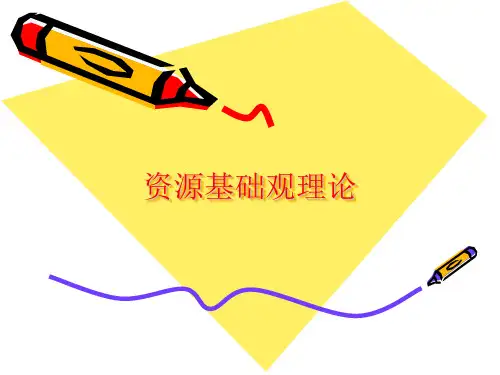
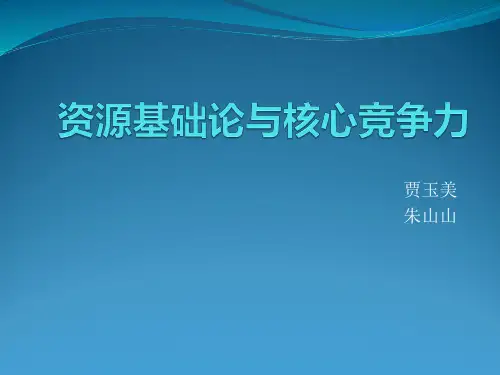
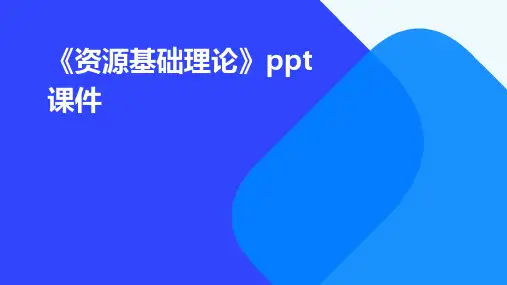
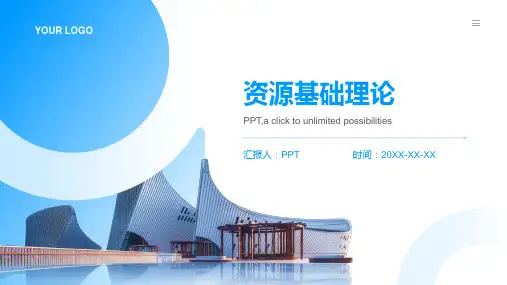
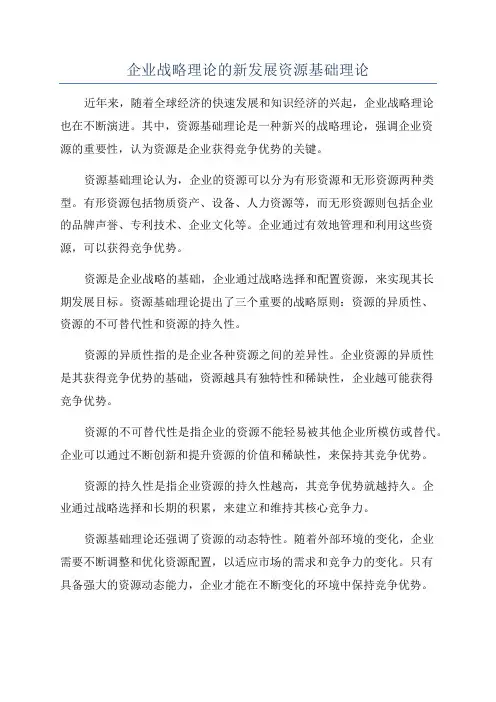
企业战略理论的新发展资源基础理论近年来,随着全球经济的快速发展和知识经济的兴起,企业战略理论也在不断演进。
其中,资源基础理论是一种新兴的战略理论,强调企业资源的重要性,认为资源是企业获得竞争优势的关键。
资源基础理论认为,企业的资源可以分为有形资源和无形资源两种类型。
有形资源包括物质资产、设备、人力资源等,而无形资源则包括企业的品牌声誉、专利技术、企业文化等。
企业通过有效地管理和利用这些资源,可以获得竞争优势。
资源是企业战略的基础,企业通过战略选择和配置资源,来实现其长期发展目标。
资源基础理论提出了三个重要的战略原则:资源的异质性、资源的不可替代性和资源的持久性。
资源的异质性指的是企业各种资源之间的差异性。
企业资源的异质性是其获得竞争优势的基础,资源越具有独特性和稀缺性,企业越可能获得竞争优势。
资源的不可替代性是指企业的资源不能轻易被其他企业所模仿或替代。
企业可以通过不断创新和提升资源的价值和稀缺性,来保持其竞争优势。
资源的持久性是指企业资源的持久性越高,其竞争优势就越持久。
企业通过战略选择和长期的积累,来建立和维持其核心竞争力。
资源基础理论还强调了资源的动态特性。
随着外部环境的变化,企业需要不断调整和优化资源配置,以适应市场的需求和竞争力的变化。
只有具备强大的资源动态能力,企业才能在不断变化的环境中保持竞争优势。
资源基础理论的发展为企业战略提供了新的思路和方法。
企业应该意识到资源的重要性,通过分析和评估自身的资源优势和劣势,有针对性地制定和实施战略。
同时,企业还需要注重资源的创新和升级,不断提升资源的价值和竞争力。
总而言之,资源基础理论是企业战略理论的新发展。
它强调了资源在企业竞争中的关键作用,提出了资源的异质性、不可替代性和持久性等战略原则。
只有通过有效地管理和利用资源,企业才能获得竞争优势,并实现其长期发展目标。
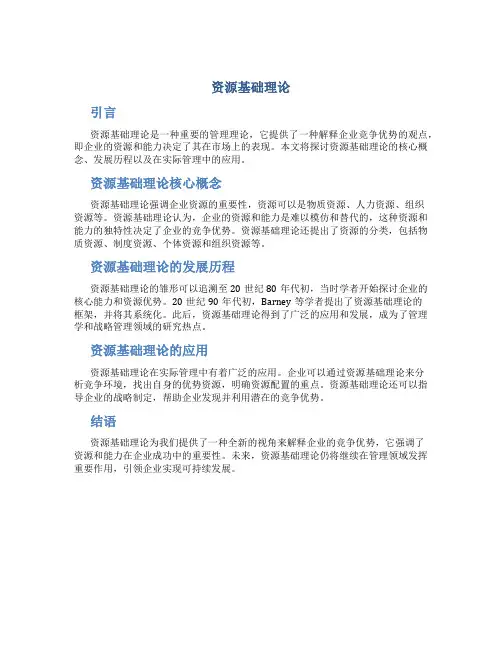
资源基础理论
引言
资源基础理论是一种重要的管理理论,它提供了一种解释企业竞争优势的观点,即企业的资源和能力决定了其在市场上的表现。
本文将探讨资源基础理论的核心概念、发展历程以及在实际管理中的应用。
资源基础理论核心概念
资源基础理论强调企业资源的重要性,资源可以是物质资源、人力资源、组织
资源等。
资源基础理论认为,企业的资源和能力是难以模仿和替代的,这种资源和能力的独特性决定了企业的竞争优势。
资源基础理论还提出了资源的分类,包括物质资源、制度资源、个体资源和组织资源等。
资源基础理论的发展历程
资源基础理论的雏形可以追溯至20世纪80年代初,当时学者开始探讨企业的核心能力和资源优势。
20世纪90年代初,Barney等学者提出了资源基础理论的
框架,并将其系统化。
此后,资源基础理论得到了广泛的应用和发展,成为了管理学和战略管理领域的研究热点。
资源基础理论的应用
资源基础理论在实际管理中有着广泛的应用。
企业可以通过资源基础理论来分
析竞争环境,找出自身的优势资源,明确资源配置的重点。
资源基础理论还可以指导企业的战略制定,帮助企业发现并利用潜在的竞争优势。
结语
资源基础理论为我们提供了一种全新的视角来解释企业的竞争优势,它强调了
资源和能力在企业成功中的重要性。
未来,资源基础理论仍将继续在管理领域发挥重要作用,引领企业实现可持续发展。
关于资源基础理论的相关论述来源:《经济管理.新管理》(2001年第12期)Rumet、Schendel和Teece在《战略管理和经济学》一文中明确指出,以20世纪70年代为开端,战略管理进入了一个全新的阶段。
与70年代之前的战略管理思想相比较,经济学的思想和方法被大量引入战略管理学,是这一阶段的最大特点。
在他们的眼中,70年代以来的阶段是战略管理与经济学相互融合的阶段(1991,P.5)。
在这一历史时期,战略管理界几乎先后出现了两个主流学派。
较早的一个是由哈佛大学的波特教授提出来的“五种力量模型”(又称竞争优势理论),几乎统治了整个80年代。
另一个是由Prahalad、Hamel等学者提出的核心能力理论,它几乎统治了80年代后期开始的战略管理学界。
然而,与波特几乎同时代还存在另一个学派,虽然这一学派的影响力不及波特教授的竞争优势理论和Prahalad等学者的核心能力理论,但是,作为与波特竞争优势理论相对应的~个学派,这一学派成功地从经济学中引入了不同于波特的芝加哥思想,为Prahalad、Hamel等学者后来提出核心能力理论提供了思想源泉(Ansoff,1987)。
这就是Barney、Rumelt、Peteraf等学者创立的资源基础理论。
一、资源基础理论的思想渊源在Rumelt、Schendel和Teece看来,“经济学对战略管理的主要贡献都来源于产业组织方面的文献”,因为(这一领域)“是经济学突破新古典的企业理论并取得重要成果的领域,在这一领域内建立了新经济学(1991,P.5)”。
这个论断,让我们回想到经济学在20世纪70年代发生的重大转折,在宏观经济学上是理性预期思想的引入。
在微观经济学上,则是现代企业理论与信息经济学的发展。
其中,与战略管理联系最密切的就是现代企业理论。
现代企业理论在思想上最大的特点就是放弃了新古典企业理论中同质性企业的假设,转而接受了差异性企业的现实,并试图用经济学的方法对这种差异给出有力的解释。
资源基础理论Fox资源基础理论(Resource-Based View,简称RBV)学术界把潘罗斯1959年出版的《企业成长论》看作资源基础理论的源头。
1984年沃纳菲尔特(Wernerfelt)的“企业的资源基础论”的发表意味着资源基础论的诞生。
资源论的假设是:企业具有不同的有形和无形的资源,这些资源可转变成独特的能力;资源在企业间是不可流动的且难以复制;这些独特的资源与能力是企业持久竞争优势的源泉。
资源论的基本思想是把企业看成是资源的集合体将目标集中在资源的特性和战略要素市场上,并以此来解释企业的可持续的优势和相互间的差异。
资源基础理论的主要内容:资源基础理论为,企业是各种资源的集合体。
由于各种不同的原因,企业拥有的资源各不相同,具有异质性,这种异质性决定了企业竞争力的差异。
概括地讲,资源基础理论主要包括以下3方面的内容:1、企业竞争优势的源:特殊的异质资源资源基础论认为,各种资源具有多种用途,其中又以货币资金为最。
企业的经营决策就是指定各种资源的特定用途,且决策一旦实施就不可还原。
因此,在任何一个时点上,企业都会拥有基于先前资源配置基础上进行决策后带来的资源储备,这种资源储备将限制、影响企业下一步的决策,即资源的开发过程倾向于降低企业灵活性。
例如,拥有1亿元货币金的企业几乎可能涉足任何产业,但它一旦将这1亿元资金用来购买了化工设备及化工原料,它就只可能从事特定的化工生产。
尽管如此,企业仍然热衷于资源的开发利用,因为资源的开发增加了资源的专用性,有可能提高产出效率及资源的价值。
如果决策得当,上面那家只能从事化工生产的企业也许会从化工生产中赚回2个亿。
2、竞争优势的持续性:资源的不可模仿性企业竞争优势根源于企业的特殊资源,这种特殊资源能够给企业带来经济租金。
在经济利益的驱动下,没有获得经济租金的企业肯定会模仿优势企业,其结果则是企业趋同,租金消散。
因此,企业竞争优势及经济租金的存在说明优势企业的特殊资源肯定能被其他企业模仿。
摘要:探讨了资源基础理论的研究现状,认为资源基础理论将企业战略理论向前推进了一大步,下一步研究将深入到知识或能力的微观活动过程,资源基础理论将演化为知识基础理论和能力基础理论,并将在最后走向融合。
关键词:企业战略企业资源企业理论1.企业战略理论的演变“二战”以来,物质产品空前丰富,世界范围内的市场逐步转化为多样化的买方市场,企业间的竞争日益激烈;科技发展日新月异,新产品大量涌现,企业面临的环境更加复杂多变。
正确把握、主动适应复杂多变的经营环境己成了关系企业生存发展的重大问题。
企业战略理论就在这一背景下兴起的,目前大致经历了3个发展阶段。
1.1经典战略理论阶段企业战略埋论在发展的初期阶段与市场呰销埋论混众在•起,主要研究企业如何寻找有利的市场机会,如何占领、开拓市场等问题《随卷战略管埋模式的规范化和系统化,建立在对内部条件和外部环境系统分析之上的经典理论形成/较完整的理论休系,SWOT分析框架逐渐流行。
概括地讲,经典战略理论主要为企业战略的制定提供了•套基本的忍路和程序:首先,分析企业相对竞争对手的实力和弱点,做到知己知彼;其次,分析外部环境提供的发展机会及可能带来的威胁:再次,结合前闹的分析确定企业的战略B标,确保既要抓住可利用的发展机会,又要规避可能出现的风险;最后处制定实现战略B标的战略步骤,架起B标和现实之间的桥梁。
正如前向'所述,经典战略埋论仅仅提供了•套力法和程序,掌握f该理论的人可能根本不会制定战略,W为分析企业的实力、弱点、机会及威胁还需要其他非常专业的知识、丨:省的经验、敏锐的洞察力1。
此外,经典战略埋论并没有告诉我们如何在SWOT分析的基础上确定战略B标和战略步骤,•切功夫都在诗外。
1.2产业分析法随者产业组织埋论的发肢,越来越多的研究者将产业分析的范式引入了战略埋论。
在这些努力中,波特宽献眾著,他在《竞争战略》■书中,提出了产业竞争结构分析的范式,指丨丨i企业赢利能力取决于其竟爭优势,而企业竟争优势又■定程度地取决于企此所在产业甚本的竞爭结构,即由五力_tf ri竞争力呈潜在竟争对手的入侵、替代品的威胁、现在竟争对手之间的竞争以及客户和供应商i、丨还价的能力所形成的竟争结构。
资源基础理论摘要:本文介绍了资源基础理论的概念和重要性,探讨了资源的分类和特征,并分析了资源基础理论在实践中的应用。
通过对资源基础理论的全面了解,可以帮助人们更好地理解资源的本质和对经济发展的重要性。
第一章:引言资源是人类社会生产和生活不可或缺的物质和非物质要素。
资源的合理利用和开发,对于促进经济发展、改善生活质量具有重要意义。
资源基础理论是研究资源的本质、特点和利用方式的重要理论体系。
在本章中,我们将介绍资源基础理论的基本概念和其在经济发展中的作用。
第二章:资源的分类和特征资源的分类是人们对资源进行整理和归纳的过程。
一般而言,资源可以分为自然资源、人力资源、资本资源和信息资源等。
自然资源包括土地资源、水资源、矿产资源等,其中土地资源是人类生存和生产的基础。
人力资源是人类智力和劳动能力的集合,是经济发展的原动力。
资本资源包括货币资本、物质资本和技术资本等,是实现经济发展和提高生产效率的重要条件。
信息资源是指信息和知识的集合,是现代经济发展的核心要素。
每种资源都具有其独特的特征。
自然资源具有固定性、稀缺性和不可替代性。
人力资源具有活力和可再生性,但也受到教育、培训和健康状况等因素的影响。
资本资源具有流动性和可替代性,但也面临着风险和不确定性。
信息资源具有瞬时性和时效性,但也需要不断更新和运用。
第三章:资源基础理论的实践应用资源基础理论在实践中具有广泛的应用价值。
首先,在资源开发和利用方面,资源基础理论能够指导决策者进行资源评估、规划和管理,以实现资源的可持续利用。
其次,资源基础理论还可以为企业和组织提供指导,帮助其合理配置资源、提高生产效率和经济效益。
此外,资源基础理论还可以为政府制定和实施相关政策提供依据,促进经济发展和社会进步。
第四章:资源基础理论的挑战与前景尽管资源基础理论在实践中取得了一些成果,但仍面临一些挑战。
首先,资源的科学评价仍然比较困难,如何客观、全面地评估资源的价值和潜力是一个重要的问题。
资源基础观应用及发展
谭凌峰
【期刊名称】《中国外资》
【年(卷),期】2011(000)012
【摘要】随着资源基础观的提出,这一观点得到了很大的发展,越来越被众多学者所使用。
本文在充分回顾研究成果的基础上,对现有资源基础文献进行了梳理,理清研究脉络,并明确了这一理论本身的发展和应用,并指出了这一理论未来的发展与研究方向。
【总页数】1页(P216-216)
【作者】谭凌峰
【作者单位】吉林大学
【正文语种】中文
【中图分类】F274
【相关文献】
1.资源基础观的大学发展:一个产权经济学分析框架 [J], 王连森
2.基于资源基础观的企业发展模式研究 [J], 孙建勇;赵道致;王元明
3.资源基础观应用及发展 [J], 谭凌峰
4.零售业低碳化与促进中国低碳零售发展的政策选择——基于企业的自然资源基础观 [J], 杨波
5.新资源基础观与湖北县域经济发展 [J], 李曼
因版权原因,仅展示原文概要,查看原文内容请购买。
4资源基础观的理论发展A Resource-Based View李玉刚博士 / 教授华东理工大学商学院yugangl@资源基础观要回答的问题⏹同行业不同企业的绩效为何长期不同?⏹对企业内部资源和核心竞争力的分析,现在一般称为资源基础学派(RBS,Resource-based school)或资源基础观点( RBV,Resource-based View )Ansoff和Andrew s⏹在战略研究中,对企业内部的优势和劣势的分析和评估作为战略制定的前提⏹Andrew s (1971) : "an internal appraisal of strengths and w eaknesses, led to identification of distinctive competencies."⏹Ansoff (1965) : synergy as "one internally generated by a combination of capabilities or competencies“⏹对企业内部因素的研究并没有深入展开资源基础的早期渊源⏹对企业内部资源和核心竞争力的分析,现在一般称为资源基础学派(RBS,Resource-based school)或资源基础观点( RBV,Resource-based View )⏹早期的三个来源⏹与众不同的竞争力理论⏹李嘉图(Ricardo,1817)的经济学⏹彭罗斯的企业成长理论与众不同的竞争力/总经理distinctive competence⏹1911年,在哈佛大学,分析组织中的总经理角色⏹总经理和企业的绩效之间的关系⏹高质量的总经理是企业的优势,低质量的总经理是企业的劣势⏹方法的局限性⏹总经理“高质”的品质和特性模棱两可⏹并不是企业优势的唯一来源与众不同的竞争力/制度性的领导能力distinctive competence⏹社会学家塞尔兹尼克 Selznick⏹制度性的领导者(constitutional leaders)⏹确保企业与众不同的价值和身份——企业与众不同的愿景租金理论⏹李嘉图(David Richardo )关注“最初的、不可扩大的、不可破坏的天赋因素”的经济结果⏹土地的总供给相对固定,供给弹性低⏹那些拥有无供给弹性的高质量生产要素的人可能获得经济租金(高于正常的经济绩效)⏹企业使用的许多资源是没有供给弹性的,并且这些资源可能成为经济租金的源泉彭罗斯的企业成长理论⏹Penrose(1959) :theory of the growth of the firm ⏹从两方面理解企业⏹企业是一个由个体和群体活动组成的行政结构⏹企业是一组生产资源⏹经理人的任务⏹通过企业已经创造的行政结构,来利用企业控制的生产资源⏹彭罗斯的研究发现⏹企业所控制的生产性资源本质上是异质的⏹将异质的资源拓展到了管理团队、高层管理人员,以及企业家技巧之类的不具备弹性的生产性资源经济学对企业专有资源的关注 企业资源理论的原始思想由来已久。
张伯伦(Chamberlin,1933)和罗宾逊(Robinson, 1933)是最早认识到企业专有资源重要性的两位经济学家。
他们认为企业独特的资产和能力是产生不完全竞争并获取超额利润的重要因素。
资源基础学派的兴起与成型⏹四篇文章⏹Wernerfelt R.1984. A Resource-based View of the Firm.Strategic Management Journal,1 P 171-180⏹Barney J B. Strategic factor markets: Expectations,luck, and business strategy. M anagement Science,1986,32:1231~1241⏹Barney J B. Firm resources and sustained competitiveadvantage. Journal of M anagement,1991,17:99~120⏹Peteraf, M. A. 1993. The cornerstones of competitiveadvantage: A resource-based view. StrategicM anagement Journal, 14: 179-191.资源基础观的核心内容⏹研究问题⏹企业之间为什么会存在差异?⏹答案⏹源自企业自创立以来由其独特发展历史所形成的异质性资源⏹核心主张⏹企业资源层面的因素较之产业层面的因素能够更好地解释企业间的绩效差异⏹核心假设⏹企业关于资源的信息是不对称的,资源在企业间的分布是异质的;资源是粘性的,不能完全地在企业间流动2个基本假设⏹企业资源的异质性⏹资源禀赋、运气、演化历史或对未来预测的不同而形成不同的资源(Barney,1986)⏹由于资源的产生没有固定的生产函数,竞争对手对于要识别这些资源是很困难的(Conner,1991)⏹企业管理层在一定经营环境里的行动具有管理自主性(managerial discretion)(Amit and Schoemaker, 1993)⏹企业的资源存量是经历“变异——选择——留存”这一演化机制长期演化的结果(Nelson and W inter,1982;Nelson,1991)⏹企业资源的不完全流动性⏹资源的不完全流动性(Barney , 1991)⏹资源移动壁垒(W arnerfelt,1984)⏹企业在关键资源上的隔离机制(Rumelt,1984,1987)资源(Resource)⏹W ernerfelt(1984):“任何可以被看成是某给定企业优势或劣势的东西,更正式地说,一企业在某给定时刻的资源可以被定义为那些半永久性附属于企业的(有形和无形)资产”。
⏹Barney(1991):“企业控制的能够使企业制订和实施提高其效率和效果的战略的所有资产、能力、组织流程、企业属性、信息、知识等等。
用传统战略分析的话来讲,企业资源是企业在制订和实施其战略时可资利用的力量” 101) 。
资源分成三大类:物力资本资源(physical capitalresources)、人力资本资源(human capital resources)和组织资本资源(organizational capital resources)。
⏹Grant( 19 91):资源是生产过程的要素投入,包括机器设备、专利、品牌和雇员的个人技能等,其本身很少具有生产性。
⏹Amit & Schoemaker(1993):资源是企业拥有或控制的要素存量。
通过与其他企业资产的协同使用以及诸如技术、管理信息系统、激励机制、管理层与员I之间的信任等等联结机制,资源被转换成最终的产品或服务。
能力(capability)⏹Grant(1991):生产活动需要众多资源的合作和协调,组合资源来完成某项任务或活动的组织流程和手段就是能力。
如果说资源是能力之源,那么能力就是竞争优势之源。
⏹Amit & Schoemaker (1993):企业能力是企业特有的、通过企业资源之间复杂的互动作用长期培育起来的、可以被抽象地看作为企业为提高其资源生产效能而衍生的中间产品。
⏹M akadok (2001):能力根深蒂固于组织及其规程之中,为企业所专有,而一般的资源则没有这种特性,或者说能力较之资源更依赖于组织。
⏹Nelson & W inter(1982):把能力)把企业能力称为“惯例”(routine),它实质上是一个企业的抽象的做事方式或重复的活动方式,它主要包括企业进行审慎思考和实施的能力,类似于个人的技巧。
Resource Vs. Capability⏹First, a capability is firm-specific since it is embeddedin the organization and its processes, w hile anordinary resource is not.⏹Second, the primary purpose of a capability is toenhance the productivity of the other resources that the firm possesses⏹ A ‘capability’ is defined as a special type of resource—specifically, an organizationally embedded nontransferable firm-specific resource w hose purpose is to improve the productivity of the other resources possessed by the firm.(Makadok, 2001)Barney (1991): VRIS criteriaFirm Resource Heterogeneity Firm Resource Immobility ValueRarenessImperfect Imitability✐History Dependent✐Causal Ambiguity✐Social Complexity SubstitutabilitySustainedCompetitiveAdvantageAdvantage⏹The Question of Value:⏹Capabilities are valuable w hen they enable a firm toconceive of or implement strategies that improve efficiencyand effectiveness.⏹Value is dependent on type of strategy:⏹Low cost strategy: low er costs (Timex)⏹Differentiator: add enhancing features (Rolex)⏹To be valuable, the capability must either⏹Increase efficiency (outputs / inputs)⏹Information system reduces customer service agents required, orincreases the number of calls the same number of agents canansw er⏹Increase effectiveness (enable some new capability notpreviously held)⏹Opening a new regional campus enables outreach to a newmarket of studentsAdvantage⏹The Question of Rareness:⏹Valuable resources or capabilities that are sharedby large numbers of firms in an industry aretherefore not rare, and cannot be a source of SCA.⏹Given the follow ing, w hich are rare?⏹A w eb server⏹An M IS instructor⏹A state-of-the-art stamping press⏹None of these are rare. Some researchers thinkonly organizational assets or resources are rare(such as culture). W hat do you think?Advantage⏹The Question of Imitability⏹Valuable, rare resources can only be sources ofSCA if firms that do not possess them cannotobtain them. They must be “imperfectly imitable”,i.e. impossible to perfectly imitate them.⏹W ays imitation can be avoided:⏹Unique Historical Conditions (Caterpillar, e.g.)⏹Causal Ambiguity (w hy resources create SCA is notunderstood, even by the firm ow ning them)⏹Social Complexity (trust, teamw ork, informalrelationships, causal ambiguity w here cause ofeffectiveness is uncertain)Advantage⏹The Question of Substitutability⏹There must be no equivalent resources that canbe exploited to implement the same strategies.⏹Forms of substitutability:⏹Duplication: Although no tw o management teams arethe same, they can be strategically equivalent, producethe same results.⏹Substitution: Very different resources can be substitutes,e.g.⏹ A charismatic leader w ith a clear vision vs. a strategicplanning dept.⏹ A superior marketing strategy for a recognized brandname.⏹ A superior technical support group for an intelligentdiagnostic softw are packageAdvantage⏹The Question of Exploitation:⏹Later research qualified this as anothercriteria for SCA. Is a firm organized toexploit the full competitive potential of itsresources and capabilities?⏹Are systems in place to enable firms tosupport the execution of a particularstrategy?Notes on “Sustainable”⏹Sustainable is not measured in calendar time.⏹Sustainable does not mean the advantage w ill last forever.⏹Sustainable suggests the advantage lasts long enough that competitors stop trying to duplicate the strategy that makes the advantage sustained.Economic PerformanceValuabl e?Rare?CostlytoImitate?Exploitedby theOrganization?CompetitiveImplicationsEconomicPerformanceNo------CompetitiveDisadvantage BelowNormalYes No---- CompetitiveParityNormalYes Yes No-- TemporaryCompetitiveAdvantageAboveNormalYes Yes Yes Yes SustainedCompetitiveAdvantageAboveNormalSpecific resourcesw hich give rise to SCA⏹Another group of researchers focused on examining specificresources which give rise to sustainable competitive advantages.⏹The resources they examined included:⏹response lags (Lippman & Rumelt, 1982)⏹routines (Nelson & Winter, 1982),⏹functionally based distinctive competencies (Hitt & Ireland, 1985,1986; Hitt, Ireland, & Palia, 1982; Hitt, Ireland, & Stadter, 1982; Snow& Hrebiniak, 1980),⏹unique combination of business experience (Huff, 1982; Prahalad &Bettis, 1986; Spender, 1989)⏹organizational culture (Barney, 1986b; Fiol, 1991)⏹invisible assets that by their nature are difficult to imitate (Itami,1987)⏹organizational learning (Teece, Pisano, & Shuen, 1997)⏹entrepreneurship (Nelson, 1991; Rumelt, 1987)⏹human resources (Amit & Schoemaker, 1993)《资产存量积累和持续竞争优势》Dierickx&Cool(1989)⏹Dierickx and Cool (1989) suggested that resources can bedifferentiated as either asset flows or asset stocks. They explained economic rent sustainability in terms of resources w ith limited strategic substitutability by equivalent assets and time compression diseconomies for firms trying to imitateresources of another firm.⏹针对Barney,提出有的组织能力(交易者的忠诚,研发的能力)不能通过在战略要素市场购买来达到,需要在组织资产存量的积累来培育组织能力⏹选择合适的战略来确定流量,如研发的费用,广告的费用,来决定存量的大小即决定组织能力大小资源基础观下的组织能力⏹领先的资源地位依赖于资源多大程度上被替代、被对手模仿⏹资产存量的模仿⏹压缩时间的非经济性(time compression diseconomies)⏹资源积累效率(asset mass efficiencies)⏹资产存量的交互关联性(interconnectedness of asset stock)⏹资产衰变性(Asset Erosion)⏹原因不明(causal ambiguity)⏹资产存量的替代⏹培育组织能力的关键⏹公司战略应含有最优流量路径,因为竞争地位由存量决定M AKADOK R. 2001 .Tow ard a synthesis of the resource-based and dynamic-capability view s of rent creation. Strategic Management Journal,22: 387–401⏹resource-picking⏹Under the resource-picking mechanism, managers gatherinformation and analysis to outsmart the resource market inpicking resources, similar to the w ay that a mutual fundmanager tries to outsmart the stock market in picking stocks.⏹capability-building⏹Under the capability-building mechanism, managers designand construct organizational systems to enhance theproductivity of w hatever resources the firm acquires⏹the tw o rent-creation mechanisms arecomplementary in some circumstances butsubstitutes in others环境变革对资源基础的影响 环境变革——资源战略柔性(Strategic flexibility;Hitt,Hoskisson,Harrison,1991)the capability of the firm to proact or respond quickly to changing competitive conditions and thereby develop and/or maintain competitive advantage.Hitt, Baibaia,Samuel(1998)⏹To develop strategic flexibility and competitive advantage,requires:⏹Exercising strategic leadership⏹Building dynamic core competences⏹Focusing and developing human capital⏹Effectively using new manufacturing and informationtechnologies⏹Employing valuable strategies (exploiting global markets andcooperative strategies)⏹Implementing new organization structures and culture(horizontal organization, learning and innovative culture,managing firm as bundles of assets)新的竞争图景建立战略柔性和竞争优势的方法动态能力的概念和分析框架⏹Dynamic Routines ( Nelson & W inter, 1982)⏹Dynamic core competencies (Lei, Hitt & Bettis, 1996)⏹Dynamic Capabilities( Teece et al. ,1997)⏹Dynamic Capabilities(Eisenhardt &M artin,2000)⏹Winter(2003) on dynamic capabilityDynamic Routines( Nelson & W inter, 1982. An Evolutionary Theory of Economics Change )⏹技巧→惯例→组织行为⏹技巧⏹在给定行为正常发生的情况下,进行一系列与目标有关的有效协调行为的一种能力⏹特点:程序化、隐性知识、选择自动进行⏹惯例⏹组织层面上相当于个人技巧的对应物⏹代表稳定有序的行动Dynamic Routines( Nelson & W inter, 1982)⏹Nelson and W inter (1982) distinguish stationary and dynamic routines.⏹Stationary routines correspond to rules such as “close the door of the factory every day at 7 p.m….” or higher-level and dynamic routines to rules ”such as …search for new techniques in such and such directions….; …w hen something goes w rong do x and send a message to y…, etc” (Coriat and Dosi, 1998).Dynamic core competencies(Lei,D.,Hitt,M.A.,& Bettis,R.Dynamic core competences through meta-learning and strategic context. Journal of M anagement, 1996, 22(4): 549-569.)⏹ A firm's core competence(s) is defined as a set of problem-defining and problem-solving insights that fosters thedevelopment of idiosyncratic strategic grow th alternatives.⏹Core competences are developed from organizational learning.⏹The learning process can be proprietary to the firm,accumulates firm-specific assets, skills and heuristics andtranslates them into new products and processes.⏹Core competences, to be effective, must be continually evolvingand changing via continuous organizational learning.⏹Core competences cannot remain static; only those firms thatcontinue to invest and upgrade their competences are able to create new strategic grow th alternatives.动态核心竞争力的开发和产出元学习meta-learning⏹元认知是个体对自己认知状态、认知过程的意识和调节,包括元认知知识和元认知体验。